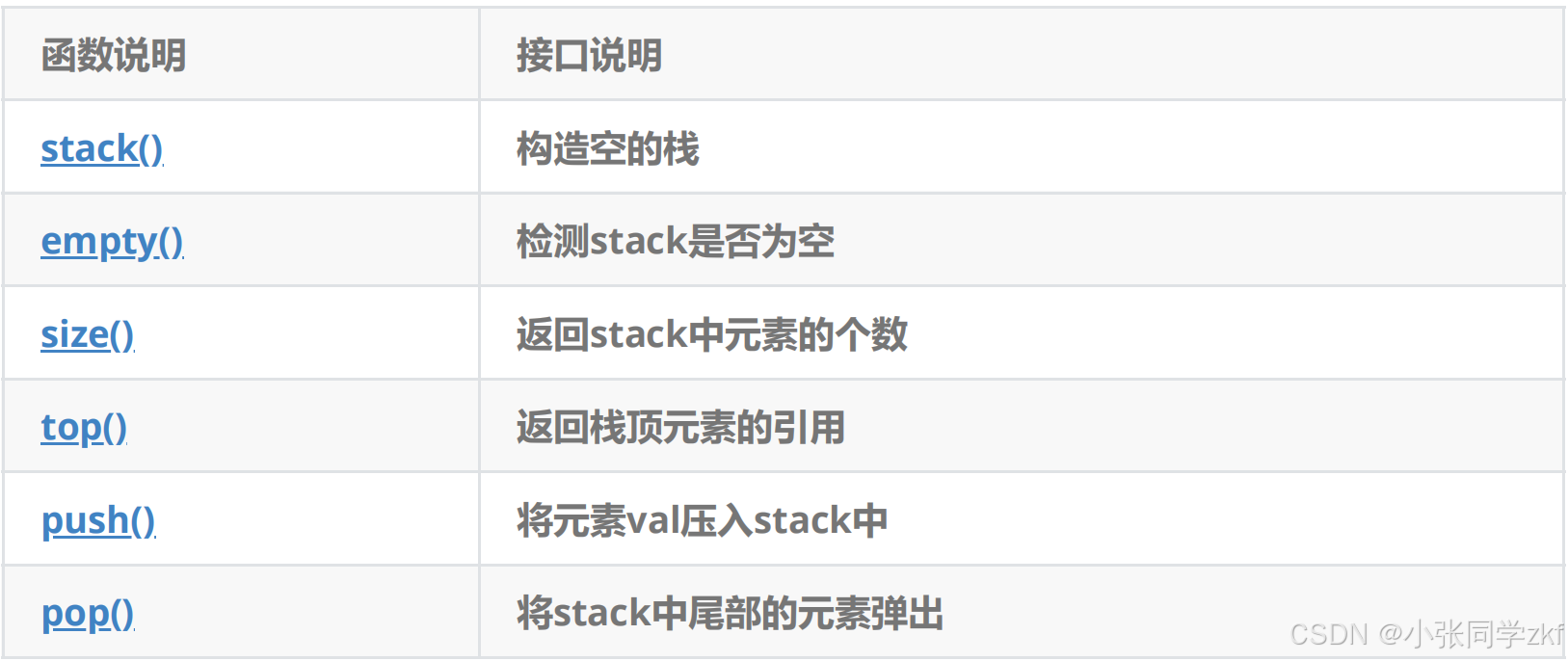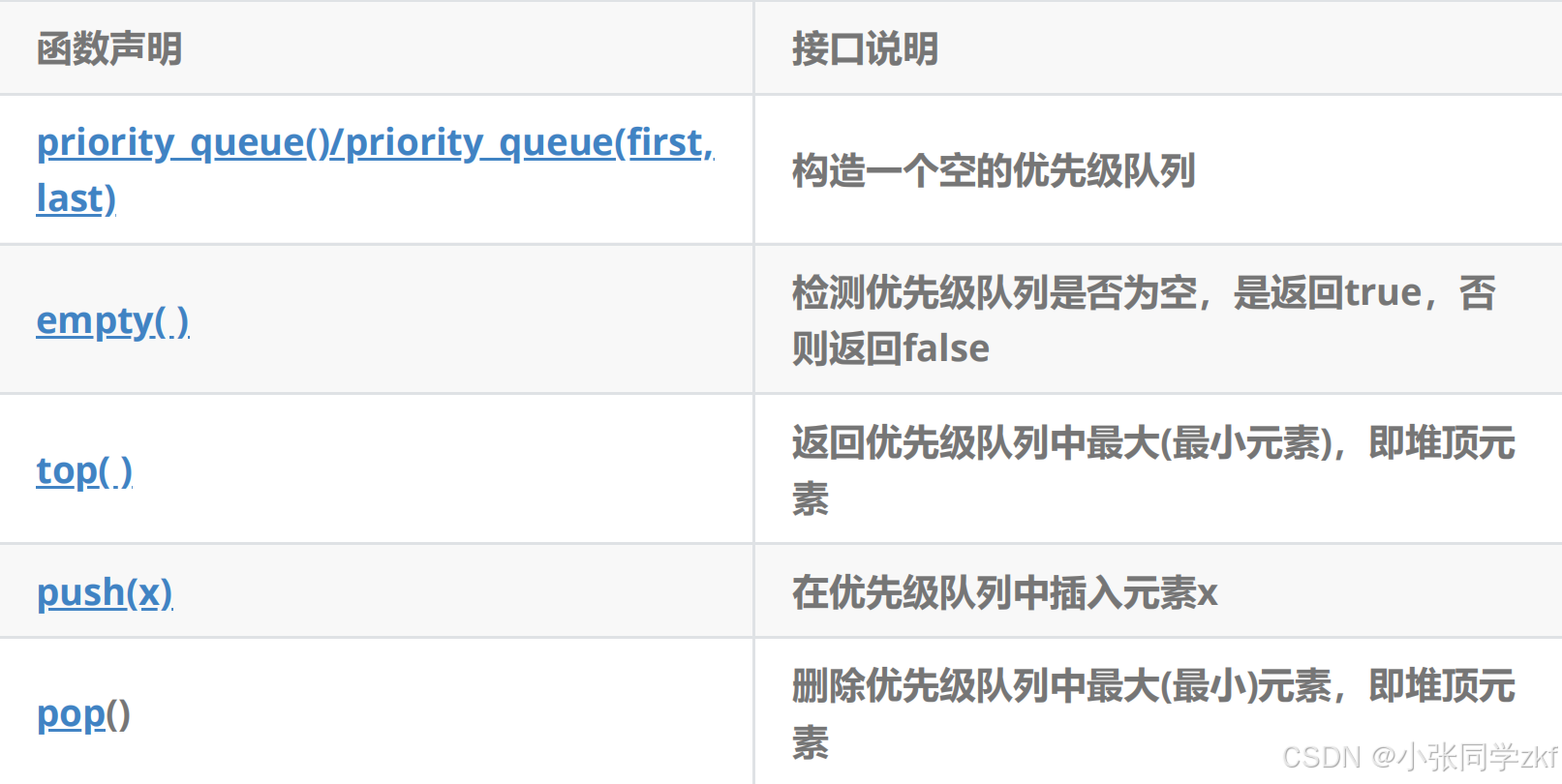【C++】STL——stack,queue
前言 这篇博客我们来看看STL库里的栈和队列结构,我们一起来看一下吧 💓 个人主页:小张同学zkf ⏩ 文章专栏:C++ 若有问题 评论区见📝 🎉欢迎大家点赞👍收藏⭐文章
1.stack介绍和使用
1.1stack介绍
stack的介绍:stack

1.2stack的使用

1.3stack的模拟实现
从栈的接口中可以看出,栈实际是一种特殊的vector,因此使用vector完全可以模拟实现stack。
栈的模拟实现代码
#include<vector> namespace bite { template < class T > class stack { public : stack () {} void push ( const T & x ) { _c . push_back ( x );} void pop () { _c . pop_back ();} T & top () { return _c . back ();} const T & top () const { return _c . back ();} size_t size () const { return _c . size ();} bool empty () const { return _c . empty ();} private : std::vector < T > _c ; }; }
2.queue介绍和使用
2.1 queue的介绍
文档:queue
1. 队列是一种容器适配器,专门用于在 FIFO 上下文 ( 先进先出 ) 中操作,其中从容器一端插入元 素,另一端提取元素。 2. 队列作为容器适配器实现,容器适配器即将特定容器类封装作为其底层容器类, queue 提供 一组特定的成员函数来访问其元素。元素从队尾入队列,从队头出队列。 3. 底层容器可以是标准容器类模板之一,也可以是其他专门设计的容器类。该底层容器应至少 支持以下操作 : empty :检测队列是否为空 size :返回队列中有效元素的个数 front :返回队头元素的引用 back :返回队尾元素的引用 push_back :在队列尾部入队列 pop_front :在队列头部出队列 4. 标准容器类 deque 和 list 满足了这些要求。默认情况下,如果没有为 queue 实例化指定容器 类,则使用标准容器 deque 。

2.2queue的使用

2.3queue的模拟实现
因为 queue 的接口中存在头删和尾插,因此使用 vector 来封装效率太低,故可以借助 list 来模拟实现queue ,具体如下:
#include <list> namespace bite { template < class T > class queue { public : queue () {} void push ( const T & x ) { _c . push_back ( x );} void pop () { _c . pop_front ();} T & back () { return _c . back ();} const T & back () const { return _c . back ();} T & front () { return _c . front ();} const T & front () const { return _c . front ();} size_t size () const { return _c . size ();} bool empty () const { return _c . empty ();} private : std::list < T > _c ; }; }
3.priority_queue的介绍和使用
3.1 priority_queue的介绍
1. 优先队列是一种容器适配器,根据严格的弱排序标准,它的第一个元素总是它所包含的元素中最大的。 2. 此上下文类似于堆,在堆中可以随时插入元素,并且只能检索最大堆元素 ( 优先队列中位于顶部的元素) 。 3. 优先队列被实现为容器适配器,容器适配器即将特定容器类封装作为其底层容器类, queue 提供一组特定的成员函数来访问其元素。元素从特定容器的 “ 尾部 ” 弹出,其称为优先队列的 顶部。 4. 底层容器可以是任何标准容器类模板,也可以是其他特定设计的容器类。容器应该可以通过随机访问迭代器访问,并支持以下操作: empty() :检测容器是否为空 size() :返回容器中有效元素个数 front() :返回容器中第一个元素的引用 push_back() :在容器尾部插入元素 pop_back() :删除容器尾部元素 5. 标准容器类 vector 和 deque 满足这些需求。默认情况下,如果没有为特定的 priority_queue 类实例化指定容器类,则使用 vector 。 6. 需要支持随机访问迭代器,以便始终在内部保持堆结构。容器适配器通过在需要时自动调用算法函数make_heap 、 push_heap 和 pop_heap 来自动完成此操作。
其实优先级队列就是数据结构中的堆!
3.2priority_queue的使用
优先级队列默认使用 vector 作为其底层存储数据的容器,在 vector 上又使用了堆算法将 vector 中 元素构造成堆的结构,因此 priority_queue 就是堆,所有需要用到堆的位置,都可以考虑使用 priority_queue 。注意:默认情况下 priority_queue 是 大堆 。

3.3priority_queue的模拟实现
#include<vector>
template <class T>
class Less
{
public:
bool operator()(const T& a, const T& b)
{
return a < b;
}
};
template <class T>
class Greater
{
bool operator()(const T& a, const T& b)
{
return a>b;
}
};
namespace zkf
{
template<class T,class container=vector<T>,class com=Less<T>>
class priority_queue
{
public:
priority_queue()
{
}
template<class inputiterator>
priority_queue(inputiterator w1, inputiterator w2)
{
while (w1 != w2)
{
push(*w1);
w1++;
}
}
com qw;
void adjustup(int child)
{
int parent= (child-1)/2;
while (child > 0)
{
if (qw(_as[parent],_as[child]))
{
swap(_as[child], _as[parent]);
child = parent;
parent = (child - 1) / 2;
}
else
{
break;
}
}
}
void push(const T& s)
{
_as.push_back(s);
adjustup(_as.size()-1);
}
void adjustdown(int parent)
{
int child = parent * 2 + 1;
while (child < _as.size())
{
if (child + 1 < _as.size()&&qw(_as[child] , _as[child + 1]) )
{
child++;
}
if (qw(_as[parent],_as[child]))
{
swap(_as[child], _as[parent]);
parent= child;
child = parent*2+1;
}
else
{
break;
}
}
}
void pop()
{
swap(_as[0], _as[_as.size() - 1]);
_as.pop_back();
adjustdown(0);
}
const T& top()const
{
return _as[0];
}
size_t size()const
{
return _as.size();
}
bool empty()const
{
return _as.size() == 0;
}
const T& operator[](size_t i)const
{
return _as[i];
}
private:
container _as;
};
}注意在实现优先级队列时,我们可以用仿函数来控制优先级顺序,默认是大堆,可以通过仿函数改编成小堆,我这里把仿函数也模拟实现了一下,注意仿函数没有私密的成员变量,是空类,将括号重载,通过创建个仿函数类的对象(也可以不用创建直接使用匿名对象),调用括号,实现比较,模拟成函数调用的样子,这就是仿函数
template <class T>
class Less
{
public:
bool operator()(const T& a, const T& b)
{
return a < b;
}
};
template <class T>
class Greater
{
bool operator()(const T& a, const T& b)
{
return a>b;
}
};结束语 STL里栈和队列还是比较简单的,下片博客我们来看一下STL里一个特殊的结构deque(双端队列)。 OK,感谢观看!!!
